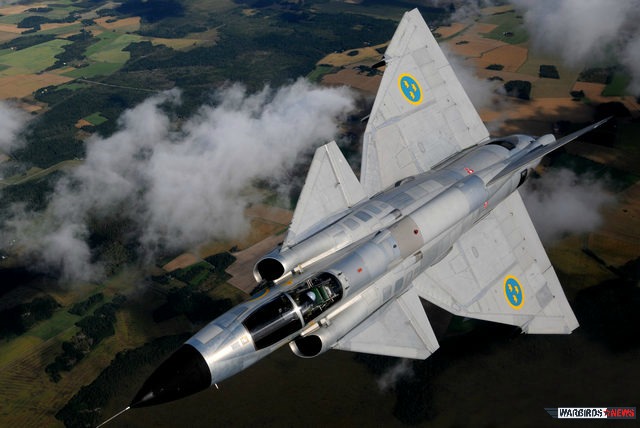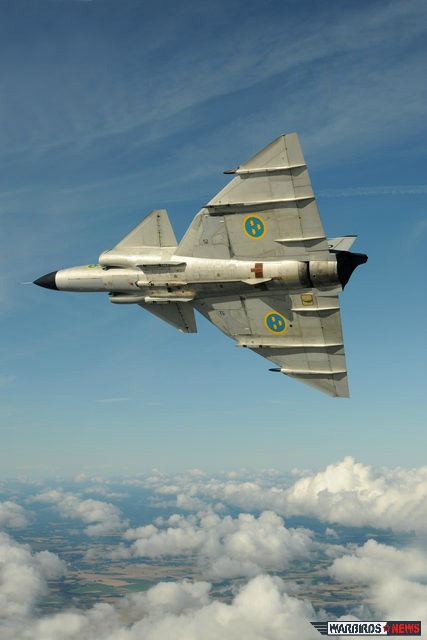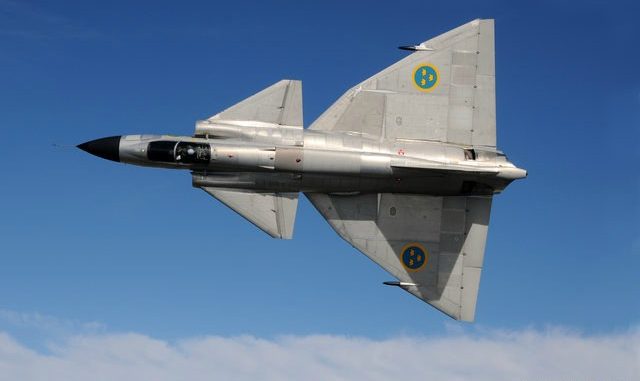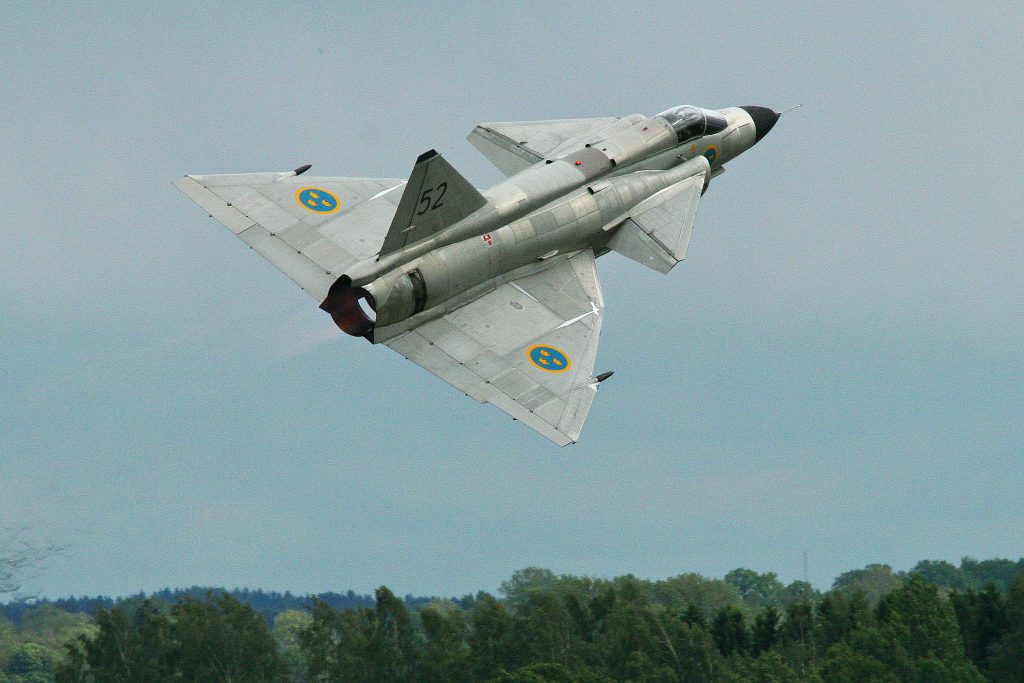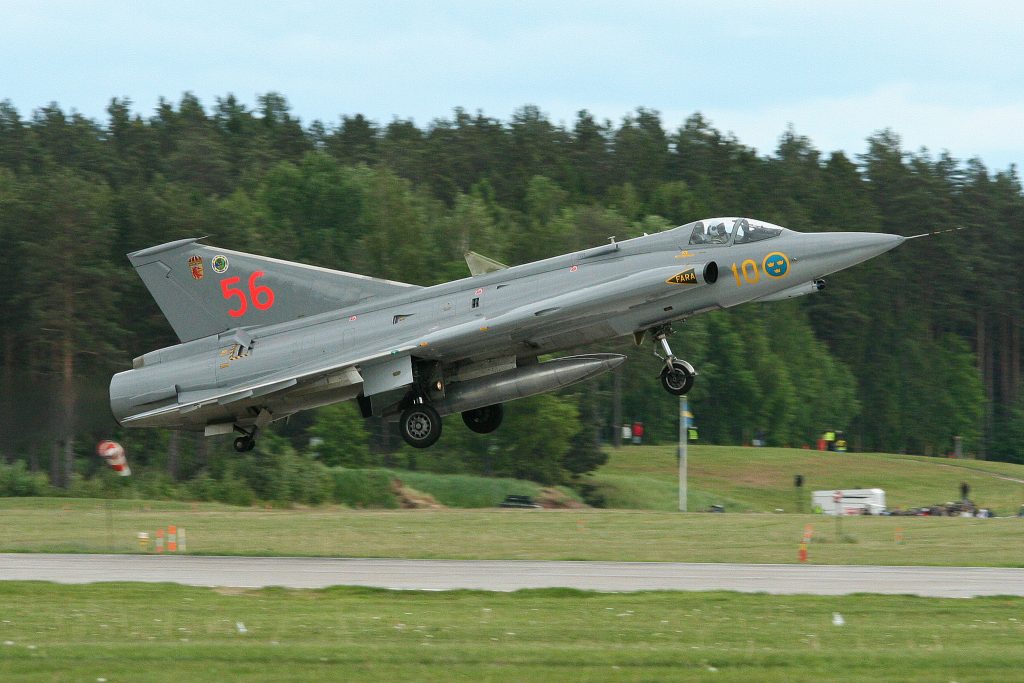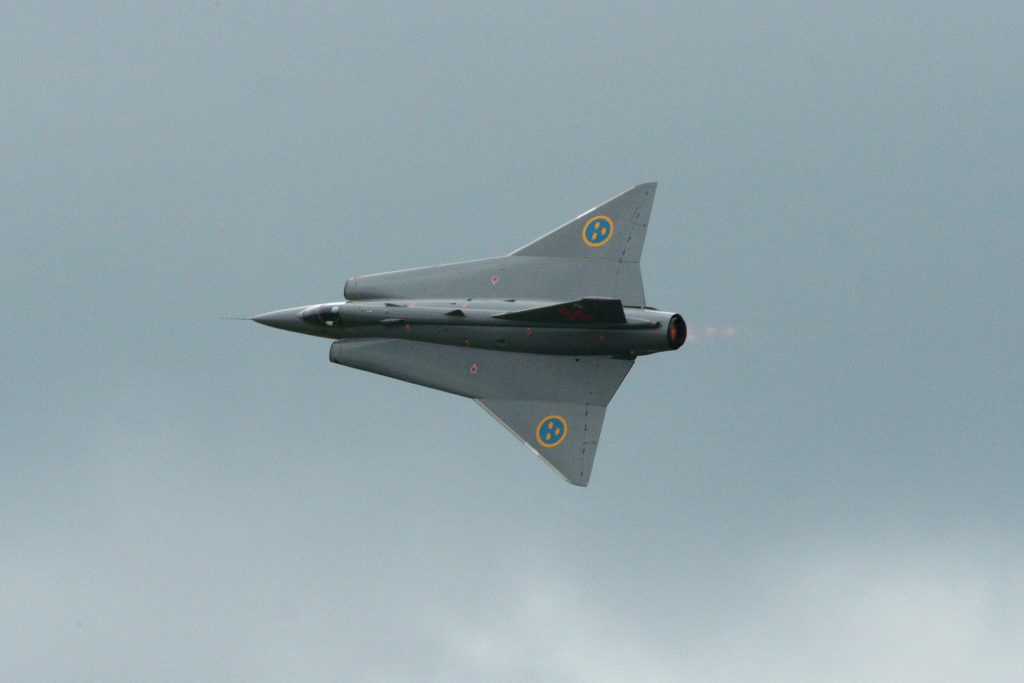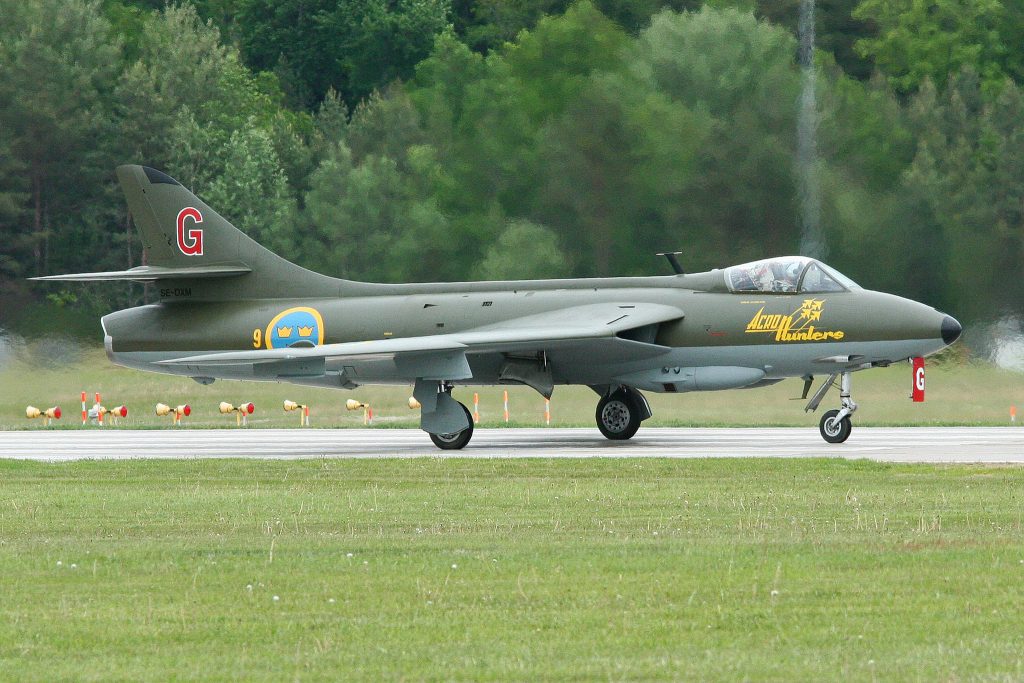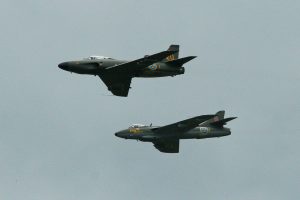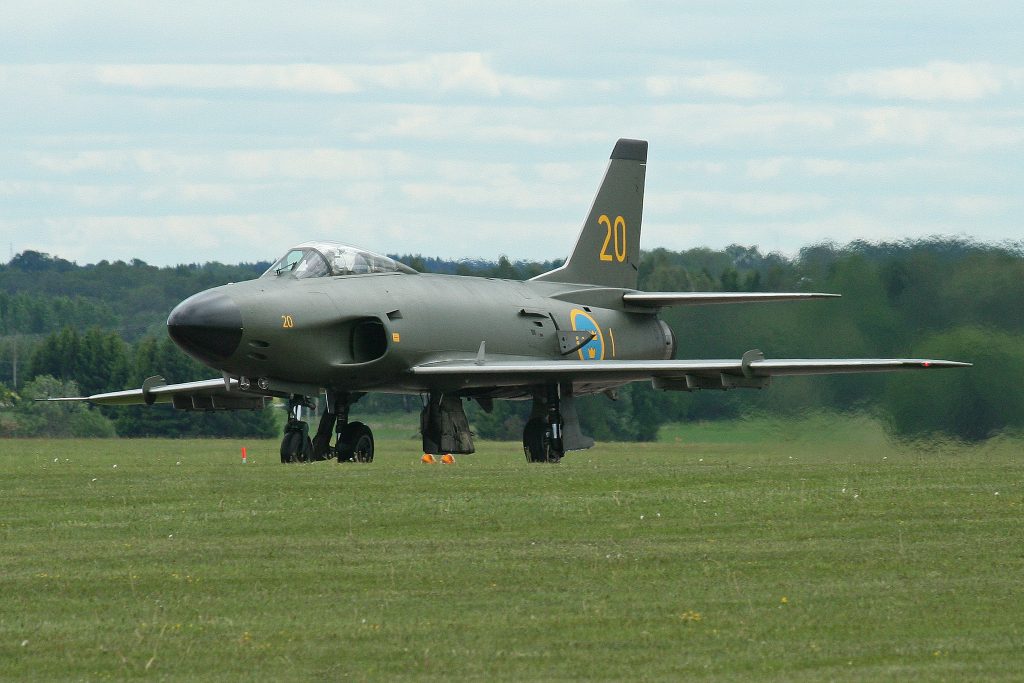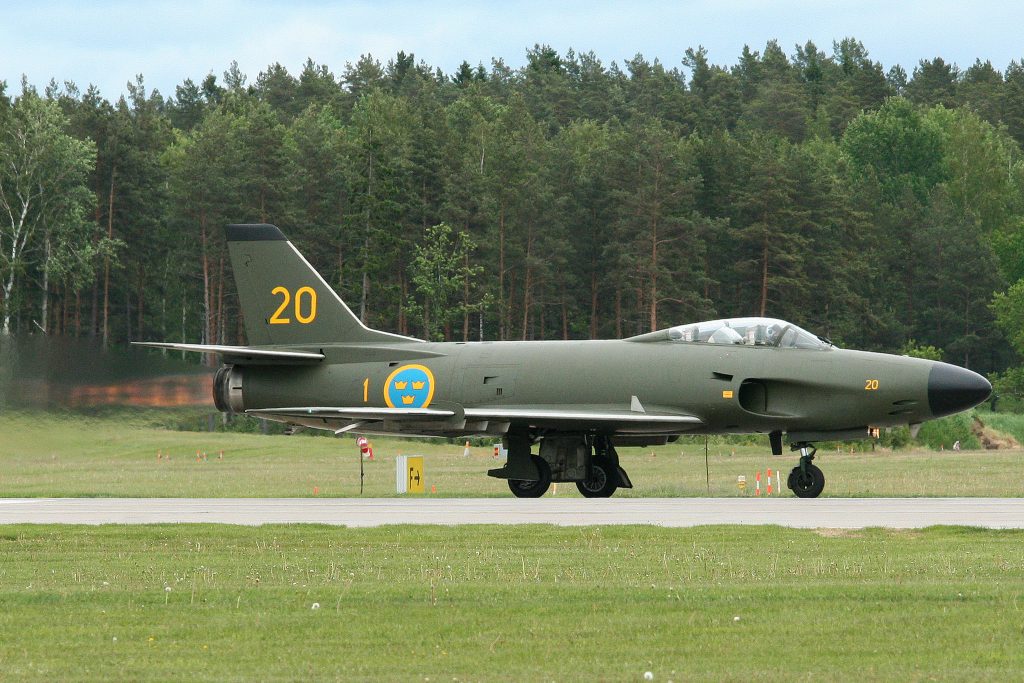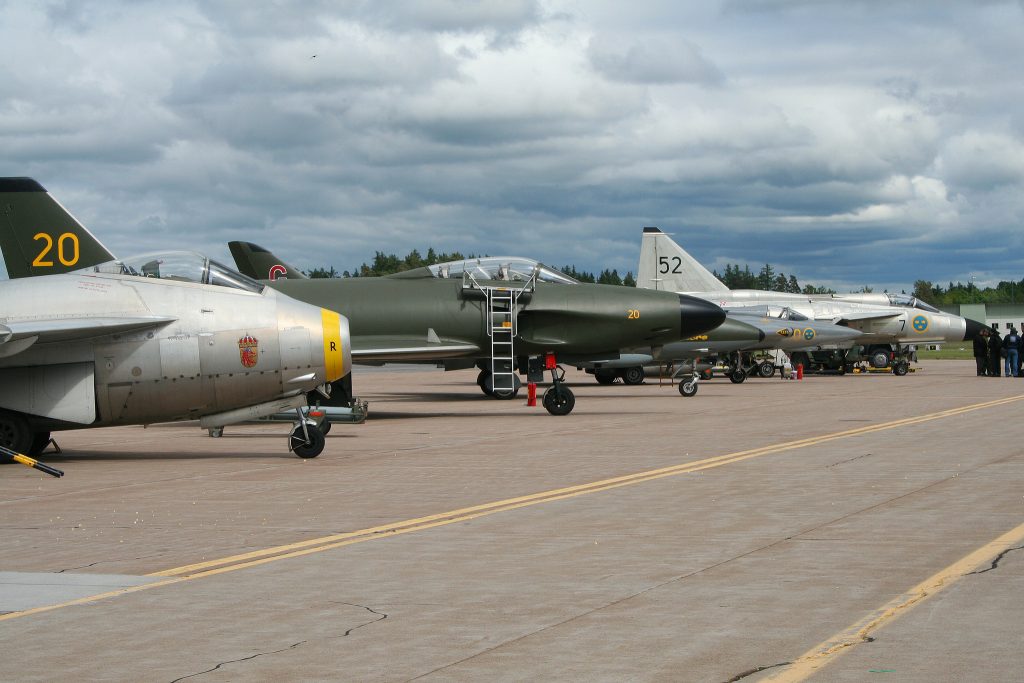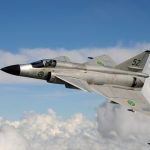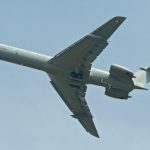As we reported yesterday, the Swedish Air Force Historic Flight (SwAFHF), a unique public/private organization that boasts an impressive fleet of airworthy warbirds, and the world’s largest collection of airworthy historic Saab fighter jets, has as its crown jewel, a recently restored and the world’s sole airworthy Saab 37 Viggen. Noted aviation photographer, journalist and author, Luigino Caliaro recently visited Linkoping, Sweden for an air display that celebrated the 75th anniversary of Saab and took the opportunity to sit down and talk to some of the assembled aviators about their experiences with these quintessential Nordic warbirds.
(Image Credit: Luigino Caliaro)
Luigino Caliaro reports:
At the June 2012 air display at Linkoping, organized to celebrate the 75th anniversary of Saab, provided the SwAFHF with an opportunity to present the Viggen to a wider audience among the general public, and numerous former pilots of this fantastic aircraft were present to witness this sole airworthy example of this legendary aircraft performing once again in Swedish skies.
Among those assembled was Major Henric Svensson, a close, personal friend and former Viggen pilot who amassed more than 1,500 hours of flight time on the Viggen while in Svenska Flygvapnet, the Swedish Air Force. After admiring the air show’s Viggen display, where the warbird was skillfully put through its paces by SwAFHF pilot Stellan Andersson, Henric and I discussed his experiences piloting this formidable fighter jet during the Cold War. His first words in describing the Viggen were, “It’s a pilot’s plane.” He further elaborated: “My previous experiences of fighters, excluding trainers and prop aircraft, are the Draken, Lansen and Tornado and my impression is that Viggen is more easy to operate in comparison. It ́s not a forgiving plane in all aspects; we were not allowed to practice super-stall (departures) in the Viggen since you might end up in a situation that couldn’t be recovered from!” Henric told me that some Viggen pilots had the opportunity to fly the Saab 35 Drakens (SK 35Cs) at the F10 wing at Ängelholm to learn super-stall handling. The “Draken Cobra” was an evasive maneuver used by some Draken pilots, similar to the better-known Sukhoi Su-27 “Cobra Maneuver,” though it was technically against air force regulations.
(Image Credit: Luigino Caliaro)
(Image Credit: Alan Wilson CC 2.0)
Henric described the flight characteristics of the Viggen: “The Viggen was a very manoeuvrable aircraft when reaching speeds above about 600 km/h. Less speed meant a rather lazy aircraft, especially in roll. To fly low, it was a dream. The aircraft was less affected than many other fighters at lower altitudes. The acceleration was tremendous; on once occasion we put the Viggen up against a Danish F-16 (an older version) and with an acceleration test from M0.6 up to M0.8 and the F-16 was easily beaten! It was also rather smooth when passing the speed of sound. You had to be cautious though, when decelerating from full afterburner / supersonic flight. You could not just fully throttle back, since this could bring you into aerodynamic trouble! The powerful engine worked great, but it burned a lot of fuel, especially with afterburner; less than 15 minutes with full (zone 3) afterburner! At low speed it was rather “speed unstable” below some 370 km/h. That meant that you lost speed at a very rapid rate when the alpha was increased. This often showed at high altitude, when trying to get VID (Visual Identification) of a bandit. To get in the right position at the right speed it sometimes demanded full afterburner to fly at just 350 km/h, since the induced drag became huge; the interceptor JA 37 Viggens however had an improved engine, optimized for higher altitudes. The stability of the Viggen made it a excellent aircraft to fly in formation, and if you needed to chase something, it was enough to just light the mighty afterburner and you soon reached the desired position. These characteristics also made it an excellent platform to deliver ordinance since it was so stable at higher speeds. The great characteristics at low level together with the quality of the navigational system also made the recon Viggen one of the best systems in the air at the time.”
(Image Credit: Alan Wilson CC 2.0)
(Image Credit: Alan Wilson CC 2.0)
While the Viggen was undisputedly the star the show and the flagship of the SwAFHF’s fleet, the Saab 35 Draken is nonetheless a major attraction, and is also the only still-flying example of its type. Based at Halmstad, in southern Sweden, the Draken is still registered to the Swedish Air Force so, unlike the Viggen, the possibility of seeing it at the major European air displays outside of Sweden are more limited. The Draken’s display pilot is Captain Peter Hedberg, an instructor at Swedish Air Force’s Air Academy, who was selected in 1997 as the official Flygvapnet Draken display pilot. He discussed his career at the controls of this venerable warbird and his display program: “I’m delighted to fly the world’s only flyable Draken and I’m convinced that is important to show our oldtimers at air shows, as many people are interested in our history and are delighted to see our beautiful Draken in flight at the numerous air shows in which we participate every summer. I love the Draken, although, of course, if I compare the Draken with the Gripen, the latter is much easier to fly. The computers help you a lot in a modern fighter compared with the older ones where the pilot has to take care of a lot himself. At high speed, Draken is wonderful to fly but at lower speeds you have to be observant of angle-of-attack, retardation of speed, and also the vertical speed towards the ground. With too an high angle-of-attack the Draken can enter a super-stall which might be hard to recover from. The Draken is also a little tricky to land due to the angle-of-attack and a rather high landing speed, 160kt. My Draken display is about 9 minutes long, and contains different kinds of rolls, loops, with looping-manoeuvres which top out at about 4000ft. Normally I finish my display program with an exciting high speed fly-by at around Mach 0.9.”
Flygvapnet Acro Hunters’ “G red.”
(Image Credit: Alan Wilson CC 2.0)
Among the others of SwAFHF’s most admired planes are the Saab 32 Lansens and the beautiful Hawker Hunter. Lieutenant Colonel Olle Norén, staff officer at the headquarters of Flygvapnet, technical officer of the SwAFHF and a demonstration pilot for several aircraft in the collection, including the Hunter and the J-29 Tunnan says that they are especially happy to display the Hunter, now proudly wearing the livery of their national air force. Previously they had displayed the craft in its original Swiss Air Force colors and markings, but when it came time to undertake a restoration of the plane the decision was made to put it in the livery a Hunter would have had in Swedish service. SwAFHF selected a scheme representing Hunter “G Red” of the Flygvapnet’s Acro Hunters aerobatic team, originally assigned to F18 at Tullinge in September 1955, and concluded its career in the colours of F9, based at Save, on in December 1968 after accumulating some 1,204 flying hours.
(Image Credit: Alan Wilson CC 2.0)
Asked about the experience of piloting the Hunter, Norén is enthusiastic: “Personally, I find flying the Hunter one of the most satisfying elements of my career as a pilot: it is simple and robust, but at the same time offers very respectable performance in flight. In fact, the Avon engine delivers excellent performance, comparable even today with some aircraft still serving with NATO air forces. Is maneuvering capabilities are excellent, and the 7.5 G limit allows us to offer an aggressive display to the public. We are convinced that thanks to the colour scheme we have adopted, our Hunter will certainly be one of the principal attractions at our national air displays.”
(Image Credit: Alan Wilson CC 2.0)
(Image Credit: Alan Wilson CC 2.0)
Other SwAFHF planes that are under military registration, and as such are rarely seen outside of Sweden, are the Historic Flight’s Saab 32 Lansens, which like the Viggen, were were only operated by the Swedish Air Force, unlike some of Saab’s other warbirds which were sold to at least some other countries’ air forces. The SwAFHF’s display pilot for the Lansen, Major Alf Ingesson Thor spoke about the flight characteristics of the Lansen: On first impression, the Lansen is huge and looks “sleepy,” but when you sit in the cockpit, you find a it has a nice and comfortable seating position and you are not aware of the plane’s size any longer. On the ground you steer with a small wheel on your right side, comfortable but you need to keep your hand there all the time. The fixed stabilator is quite slow to move, but on the other hand you don’t need to adjust your trim so often. Preparing for a landing takes more time as you need to reduce speed before lowering the landing gear, then you need to further reduce speed before deploying full flaps, and you need to trim fully backwards otherwise the elevator does not have force enough to rotate and you come down hard. The Lansen is “slippery,” meaning that it builds speed quickly. In an aerobatic performance, having your nose down, you need to reduce power or pull many Gs, otherwise the speed comes to fast. If you go beyond M0.92 the hydraulic system does not have enough force transmit your steering input. The stick become stiff and you can only pull maybe 2Gs until the speed goes below 0.92. The Lansen is not alone in this, the Draken has the same problem. When accelerating in level flight with afterburner you reach M0.92 very quickly and the nose will feel very heavy. Going supersonic is possible but you need 12 km height and almost vertical dive with full afterburner to reach M 1.02. In that speed you have to fight the stick and Lansen seems to have a mind of its own, you are merely a passenger. The Lansen is easy enough to land, but you need to know that at low speeds the ailerons becoming more and more useless due to the shape af the swept wings, requiring input from the rudder.”
(Image Credit: Alan Wilson CC 2.0)
Founded in 1998, in the span of just a few years, the SwAFHF went from non-existant to boasting an incredible collection of aircraft that extensively document Sweden’s unique aviation history, and preserves that proud legacy for future generations to experience first-hand the sights, sounds and smells of the machines of the manned aerial combat era and learn about the heroes who piloted them.







